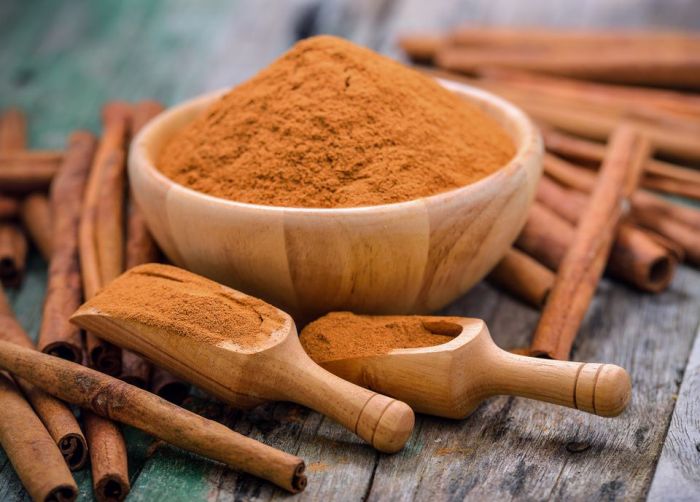What is cinnamon allergy? A cinnamon allergy, much like any food allergy, can trigger a range of uncomfortable and sometimes serious reactions. Understanding the different types of cinnamon, the potential symptoms, and how to manage them is crucial for anyone who suspects they might be affected. This guide delves into the complexities of cinnamon allergies, providing insights into their causes, symptoms, treatment options, and preventive measures.
Cinnamon, a popular spice used in countless cuisines worldwide, can sometimes trigger allergic reactions in sensitive individuals. This can manifest in various ways, from mild skin irritation to severe, life-threatening anaphylaxis. This comprehensive guide will explore the intricacies of cinnamon allergies, shedding light on the types of cinnamon, the associated symptoms, and the crucial steps to take in case of an allergic reaction.
Introduction to Cinnamon Allergy
A cinnamon allergy is a hypersensitivity reaction to the spice cinnamon, a common ingredient in various foods and beverages. It’s characterized by an overreaction of the immune system to proteins found in cinnamon, triggering a cascade of symptoms. While cinnamon is generally considered safe for consumption, some individuals experience adverse reactions, ranging from mild discomfort to severe complications.
Understanding the triggers, symptoms, and prevalence of cinnamon allergies is crucial for preventing and managing these reactions effectively.Cinnamon allergies are not as prevalent as allergies to other common foods like peanuts or milk. However, they can still cause significant discomfort and require careful management. This detailed look into cinnamon allergies aims to provide a comprehensive understanding of this condition, helping individuals recognize and address potential reactions.
Common Symptoms of a Cinnamon Allergy
Allergic reactions to cinnamon can manifest in a variety of ways, affecting different parts of the body. The most common symptoms include skin rashes, hives, and itching. These skin reactions can range from mild redness and irritation to more severe welts and blisters. Other common symptoms include gastrointestinal distress, such as nausea, vomiting, and stomach cramps. Respiratory issues, such as coughing, wheezing, or difficulty breathing, are less common but can occur in severe cases.
In rare instances, an allergic reaction to cinnamon can lead to anaphylaxis, a life-threatening condition requiring immediate medical attention.
Prevalence of Cinnamon Allergies
Precise figures on the prevalence of cinnamon allergies are challenging to obtain. Data collection on food allergies is often incomplete and varies depending on the population studied. However, based on available studies and clinical observations, cinnamon allergies appear to be relatively uncommon compared to other common food allergies. The actual prevalence is likely underestimated due to the varying degrees of severity and the potential for misdiagnosis.
Potential Triggers for Cinnamon Allergies
Cinnamon allergies are triggered by the proteins present in cinnamon. These proteins can be present in various forms of cinnamon, such as ground cinnamon, cinnamon sticks, and cinnamon extracts. Cross-contamination is also a potential trigger, especially in food processing environments where cinnamon-containing products are handled. Individuals with a history of other allergies, particularly to related spices or plants, may have an increased risk of developing a cinnamon allergy.
Mechanisms Behind Cinnamon Allergy Reactions, What is cinnamon allergy
The immune system’s response to cinnamon involves a complex cascade of events. When an individual with a cinnamon allergy consumes cinnamon, the immune system identifies cinnamon proteins as foreign invaders. This triggers the release of histamine and other inflammatory mediators, resulting in the characteristic symptoms of an allergic reaction. The specific mechanisms are still being investigated, but the underlying principle is an exaggerated immune response to a normally harmless substance.
Different Types of Cinnamon and Their Allergenic Potential
| Cinnamon Type | Allergenic Potential | Symptoms | Precautions |
|---|---|---|---|
| Cassia Cinnamon | Potentially higher | Skin rash, hives, itching, nausea, vomiting, gastrointestinal distress | Avoidance, especially for individuals with known allergies to similar spices or plants. |
| Ceylon Cinnamon | Potentially lower | Nausea, vomiting, gastrointestinal distress, in rare cases, skin reactions | Caution, especially for individuals with a history of allergies. |
The table above highlights the potential allergenic differences between Cassia and Ceylon cinnamon. While Ceylon cinnamon is generally considered less allergenic, individual reactions can vary. It’s crucial for individuals with suspected allergies to consult with a healthcare professional for accurate diagnosis and personalized guidance.
Symptoms and Diagnosis

A cinnamon allergy, like other food allergies, can manifest in a variety of ways. Recognizing these symptoms is crucial for prompt diagnosis and treatment. Understanding how cinnamon allergy symptoms differ from those of other conditions helps in accurate identification. This section delves into the specifics of symptoms, diagnostic methods, and crucial distinctions.
Physical Symptoms of a Cinnamon Allergy
Cinnamon allergy symptoms can range from mild to severe. Common reactions include skin rashes, hives, and itching. These symptoms often appear shortly after consuming cinnamon-containing foods or products. Gastrointestinal issues such as stomach cramps, nausea, and vomiting are also possible, and in severe cases, anaphylaxis can occur. This is a life-threatening reaction requiring immediate medical attention.
Symptoms can vary significantly from person to person, and the severity of the reaction depends on several factors, including the amount of cinnamon ingested and the individual’s sensitivity.
So, you’re curious about cinnamon allergies? Basically, a cinnamon allergy is a reaction to the spice, much like any other food allergy. It can manifest in various ways, from skin rashes to digestive issues. Interestingly, if you have joint pain, and are looking for ways to strengthen your legs, exploring leg exercises for bad knees like squats and lunges, leg exercises for bad knees might be a good place to start.
Ultimately, if you suspect a cinnamon allergy, consult a doctor for proper diagnosis and treatment.
Differentiating Cinnamon Allergy from Other Conditions
Identifying a cinnamon allergy involves distinguishing it from similar conditions. Symptoms like skin rashes and hives can occur in various allergic and non-allergic reactions. For instance, contact dermatitis, caused by skin contact with allergens, can mimic a cinnamon allergy. Other food allergies also exhibit overlapping symptoms. Thorough evaluation by a medical professional is essential for accurate diagnosis.
A detailed medical history, including a complete list of foods consumed and any other potential allergens, can aid in determining the cause of the reaction.
Importance of Seeking Medical Attention
Seeking immediate medical attention for suspected cinnamon allergies is paramount, especially if experiencing severe symptoms. Symptoms like difficulty breathing, swelling of the throat or face, or loss of consciousness are clear indicators of a severe reaction, necessitating immediate medical intervention. Early intervention can prevent complications and ensure a swift recovery.
Diagnostic Methods for Cinnamon Allergies
Several diagnostic methods can help identify a cinnamon allergy. A detailed medical history and physical examination are crucial initial steps. Skin prick tests, where a small amount of cinnamon extract is applied to the skin, can help identify an allergic reaction. Blood tests, measuring the presence of specific immunoglobulin E (IgE) antibodies to cinnamon, can also confirm an allergy.
The most accurate diagnosis often involves a combination of these methods.
Comparison of Cinnamon Allergy Symptoms with Other Food Allergies
| Symptom | Cinnamon Allergy | Other Food Allergies |
|---|---|---|
| Skin rash | Possible, often localized to areas of contact or ingestion | Possible, varying in location and severity depending on the allergen |
| Hives | Possible, often appearing as welts on the skin | Possible, often itchy and accompanied by other symptoms |
| Gastrointestinal issues | Possible, including nausea, vomiting, and stomach cramps | Possible, including nausea, vomiting, diarrhea, and abdominal pain, specific to the allergen |
| Respiratory issues | Possible, including shortness of breath, wheezing, and coughing | Possible, including shortness of breath, wheezing, and coughing, depending on the allergen |
This table provides a general comparison. Individual reactions can vary significantly. It’s essential to consult a healthcare professional for a personalized diagnosis and management plan.
Treatment and Management
Managing a cinnamon allergy involves a multi-faceted approach focused on avoidance and symptom relief. Understanding the triggers and recognizing the severity of your reaction are crucial steps in effective management. This approach prioritizes preventing future exposures and mitigating any potential health complications.
Avoiding Cinnamon
Proper avoidance is paramount in managing a cinnamon allergy. This means meticulously reviewing ingredient lists and carefully scrutinizing food labels. Cinnamon is surprisingly common in various processed foods, from baked goods and cereals to sauces and even some medications. Failing to recognize cinnamon’s presence can lead to accidental exposure and subsequent allergic reactions. Complete avoidance is the cornerstone of successful allergy management.
Antihistamines
Antihistamines are frequently prescribed to alleviate the symptoms of a cinnamon allergy. These medications work by blocking the effects of histamine, a chemical released by the body during an allergic response. Common symptoms such as hives, itching, and nasal congestion can be significantly reduced with antihistamines. Over-the-counter and prescription options are available, with varying degrees of effectiveness and potential side effects.
Consult a doctor to determine the most appropriate antihistamine for your specific needs.
Epinephrine Auto-Injectors
In severe cases, epinephrine auto-injectors (like EpiPens) are crucial for managing anaphylaxis, a life-threatening allergic reaction. These devices deliver a dose of epinephrine, a hormone that rapidly reverses the effects of anaphylaxis by constricting blood vessels and opening airways. Individuals with a history of severe cinnamon reactions should always carry an epinephrine auto-injector and know how to use it correctly.
Prompt administration of epinephrine can be critical in preventing potentially fatal outcomes.
Common Cinnamon-Containing Foods to Avoid
Identifying foods containing cinnamon is essential for effective avoidance. A comprehensive list of common items to avoid can significantly reduce the risk of allergic reactions. Here’s a table of some frequently encountered cinnamon-containing foods:
| Category | Examples |
|---|---|
| Baked Goods | Cakes, cookies, pastries, muffins, bread |
| Breakfast Cereals | Many breakfast cereals and granola bars |
| Spices and Seasonings | Various spice blends, rubs, and sauces |
| Processed Foods | Processed meats, soups, and sauces |
| Snacks | Certain snack mixes and granola |
| Dairy Products | Some yogurts and flavored milks |
| Medicinal Products | Certain medications and supplements |
This table provides a starting point for recognizing common cinnamon sources. It’s crucial to remember that this is not an exhaustive list, and always double-check labels for the presence of cinnamon. Always consult with an allergist for personalized guidance.
A cinnamon allergy, like any other food allergy, can manifest in various ways. Sometimes, it’s just a mild reaction, but in some cases, it can be quite serious. Visualizing different hand conditions, like those in arthritis hand photo gallery , can help people understand how allergies can impact the body. Ultimately, recognizing the symptoms of a cinnamon allergy is key to managing potential reactions and ensuring your overall well-being.
Prevention and Safety Measures
Preventing a cinnamon allergy reaction often involves proactive measures. Understanding how cinnamon can trigger a reaction and taking steps to minimize exposure is crucial for those with a known sensitivity or those who suspect they might be susceptible. This proactive approach can significantly reduce the risk of unpleasant or even dangerous allergic reactions.
Identifying Cinnamon in Foods
Careful food labeling is essential for preventing accidental exposure to cinnamon. Many processed foods, baked goods, and even medications contain cinnamon as an ingredient, often listed under various names. Mislabeling or hidden ingredients can make it difficult to identify cinnamon’s presence in unexpected places.
- Reading Food Labels Carefully: Thoroughly scrutinize ingredient lists. Look for the word “cinnamon” or any synonyms such as “cassia,” “cinnamon bark,” “cinnamon oil,” and similar terms. Pay close attention to the order of ingredients, as those listed earlier typically appear in higher concentrations. This is especially critical for individuals with severe allergies. Many products also include “natural flavorings” which may include cinnamon or other allergens, so scrutinize these closely as well.
- Identifying Hidden Cinnamon: Cinnamon is a common spice used in various food products. Sometimes it’s present in processed foods, like sauces, soups, and even some medications. Pay attention to ingredients like “natural flavorings,” which can mask the presence of cinnamon or other potential allergens. Look out for processed foods where cinnamon might be an unexpected additive. This vigilance is crucial for those prone to allergic reactions.
Safe Handling and Preparation of Cinnamon-Containing Foods
Proper handling and preparation techniques can minimize exposure risks. This is especially relevant for those with a documented cinnamon allergy or those with a suspected sensitivity.
- Separate Utensils and Surfaces: Use separate cutting boards, utensils, and cookware when preparing cinnamon-containing foods to prevent cross-contamination with other foods. This is a crucial measure to avoid inadvertent exposure to cinnamon.
- Thorough Washing: Wash your hands thoroughly after handling cinnamon-containing foods to prevent accidental transfer of cinnamon particles to other food items or surfaces. This is a simple yet effective preventative measure.
- Avoid Cinnamon in Cooking Areas: If possible, avoid having cinnamon in areas where you cook other foods. This strategy can reduce the chance of accidental cross-contamination. For instance, consider storing cinnamon in a different part of the kitchen or keeping it separate from other food items.
List of Foods and Products Frequently Containing Cinnamon
Many foods and products may contain cinnamon, and recognizing these can help avoid accidental exposure. Understanding the prevalence of cinnamon in various food categories is important.
| Category | Examples |
|---|---|
| Baked Goods | Cakes, cookies, pastries, bread |
| Processed Foods | Sauces, soups, cereals, instant noodles, processed meats |
| Snacks | Cinnamon-flavored snacks, granola bars, and other breakfast cereals |
| Drinks | Some hot beverages, flavored coffees, and teas |
| Medications | Certain medications and supplements |
Cinnamon Allergy in Specific Populations
Cinnamon allergies, while less common than other food allergies, can have varying impacts on different groups of people. Understanding these specific vulnerabilities is crucial for effective management and prevention. This section delves into the potential effects of cinnamon allergies on children, those with other conditions, and pregnant women, along with a comparison to other common food allergies.Understanding the nuances of cinnamon allergies across diverse populations can help in developing personalized strategies for managing this condition.
This can range from adapting dietary guidelines for children to offering specific precautions for pregnant women and individuals with pre-existing health conditions.
Impact on Children
Cinnamon allergies in children can present unique challenges. Children’s developing immune systems and varying dietary habits can make managing these allergies more complex. Reactions can range from mild skin rashes to more severe symptoms, including difficulty breathing. Early diagnosis and appropriate management are essential to prevent potential complications and ensure a healthy development. Parents and caregivers should be vigilant in monitoring for any unusual reactions after introducing cinnamon or cinnamon-containing foods.
Link to Other Conditions
Individuals with certain pre-existing health conditions, such as asthma or eczema, might be more susceptible to developing allergic reactions to cinnamon. The underlying inflammatory responses in these conditions could potentially exacerbate allergic reactions. It’s vital for individuals with these conditions to be particularly cautious when consuming cinnamon and to consult with healthcare professionals for personalized guidance.
Potential Risks During Pregnancy
Cinnamon allergy during pregnancy, although less commonly reported, can still pose potential risks to both the mother and the developing fetus. The effects of allergic reactions on the pregnant woman’s health can affect her overall well-being, impacting the development of the fetus. Carefully monitoring any reactions and seeking medical advice from a healthcare provider are crucial steps to take during pregnancy.
Considerations for Individuals with Pre-existing Health Conditions
Individuals with pre-existing health conditions, including asthma, eczema, or other allergies, should be extra cautious about cinnamon consumption. Their immune systems might be more reactive, leading to more intense or prolonged reactions. Regular consultation with a healthcare provider is recommended to develop a tailored management plan.
Comparison to Other Common Food Allergies
Cinnamon allergy shares some similarities with other common food allergies, such as those to peanuts or dairy. Allergies often manifest with similar symptoms, including skin rashes, digestive problems, and respiratory distress. However, the specific triggers and reactions can vary. Knowing the characteristics of different food allergies can help individuals identify potential patterns and take appropriate preventative measures. It is essential to recognize that while the symptoms might overlap, the underlying mechanisms and management strategies might differ, highlighting the importance of personalized approaches to allergy management.
Interactions and Cross-reactivity
Cinnamon allergy, like many other food allergies, can sometimes manifest in unexpected ways. Understanding the potential for cross-reactivity with other foods and spices is crucial for effective management and prevention of allergic reactions. This intricate connection can lead to reactions beyond simply consuming cinnamon, making careful consideration of dietary choices essential.
Potential for Cross-Reactivity with Other Spices
Many spices share similar chemical structures and aromatic compounds. This structural similarity can sometimes trigger allergic reactions in individuals sensitive to one spice when exposed to another. For instance, individuals with a cinnamon allergy might also experience reactions to nutmeg or ginger due to shared chemical compounds and the activation of similar immune responses.
Links Between Cinnamon Allergy and Other Food Allergies
The connection between cinnamon allergy and other food allergies is not always straightforward, but it’s a significant factor to consider. Certain food allergens may have shared antigenic epitopes, which are specific regions on proteins that trigger an immune response. When an individual is sensitized to one allergen, their immune system may react similarly to allergens with similar epitopes, potentially resulting in cross-reactivity.
Mechanisms of Cross-Reactivity
The underlying mechanisms behind cross-reactivity often involve the immune system’s response to specific proteins. Proteins in cinnamon, as well as other spices, possess particular amino acid sequences that can trigger an allergic response. When these proteins are processed and presented by the immune system, they can lead to the production of antibodies that react not only to cinnamon but also to structurally similar proteins in other foods.
So, what exactly is a cinnamon allergy? It’s a reaction your body has to cinnamon, a spice often used in cooking. While less common than other food allergies, it can manifest in various ways, from mild skin rashes to more serious breathing difficulties. Interestingly, some studies suggest a potential link between cinnamon allergy and the body’s response to certain nutrients, such as omega 3 fatty acids , which are crucial for overall health.
Ultimately, if you suspect you might have a cinnamon allergy, it’s always best to consult with a healthcare professional for proper diagnosis and management.
This cross-reactivity is often mediated by IgE antibodies, which are a type of antibody associated with immediate hypersensitivity reactions.
Potential Cross-Reactive Food Allergens Related to Cinnamon
Identifying potential cross-reactive allergens is crucial for preventing reactions. A variety of spices and even some fruits might share similar proteins or chemical compounds with cinnamon, triggering allergic responses.
Table of Potential Cross-Reactive Allergens to Cinnamon
| Potential Cross-Reactive Allergen | Description | Similarity to Cinnamon |
|---|---|---|
| Other Spices (Nutmeg, Ginger, Allspice) | These spices share aromatic compounds and potentially similar protein structures with cinnamon. | Similar aromatic compounds and possible shared protein epitopes. |
| Certain Fruits (e.g., Apples, Pears) | Some fruits may share specific protein structures with cinnamon. | Potentially shared protein structures that trigger cross-reactivity. |
| Certain Vegetables | Certain vegetable families may have proteins with similarities to cinnamon’s constituents. | Potential for shared proteins, requiring further research. |
Importance of Professional Advice: What Is Cinnamon Allergy

Navigating a cinnamon allergy requires a careful approach, especially concerning diagnosis and management. Self-treating can lead to complications and potentially mask underlying issues, which is why professional guidance is paramount. Understanding the nuances of your specific reaction is crucial, and a healthcare professional can provide personalized strategies for managing your allergy effectively.Seeking professional advice ensures you receive the best possible care tailored to your individual needs.
A qualified allergist can accurately assess your condition, develop a comprehensive treatment plan, and monitor your progress, leading to better outcomes and preventing future complications.
Crucial Role of Diagnosis and Management by Professionals
Accurate diagnosis is the cornerstone of effective allergy management. A healthcare professional can perform comprehensive allergy testing to identify specific triggers, including cinnamon. This precise identification allows for targeted treatment and avoids unnecessary interventions. Incorrect self-diagnosis could lead to misdirected treatments, delaying the actual cause and worsening symptoms. The professional approach ensures that any related health issues are addressed thoroughly, rather than just treating symptoms.
Significance of Personalized Treatment Plans
Every individual reacts differently to allergens. A personalized treatment plan considers individual factors, including the severity of the allergy, concurrent medical conditions, and lifestyle preferences. A generic approach to cinnamon allergy management might not address the unique needs of each person. For instance, a severe reaction might require stricter avoidance measures, while a mild reaction could be managed with milder strategies.
A personalized plan allows for customized solutions that are more likely to be effective and prevent future complications.
Necessity of Allergy Testing and Professional Guidance
Allergy testing, performed by a qualified allergist, is crucial for confirming a cinnamon allergy and determining its severity. This testing often involves skin prick tests or blood tests. These tests help differentiate between various potential causes for symptoms, ensuring accurate identification and management. Without proper testing, it is challenging to distinguish between a cinnamon allergy and other conditions that might share similar symptoms, potentially leading to incorrect treatment.
Professional guidance ensures accurate identification and tailored management.
Resources for Finding Qualified Allergists
Finding a qualified allergist is vital for effective management. Consult your primary care physician for recommendations. Online resources, such as the American Academy of Allergy, Asthma & Immunology (AAAAI) website, offer directories of allergists in your area. Checking online review platforms for allergists can provide valuable insight into the expertise and experience of different professionals. These resources provide a starting point for identifying specialists who possess the necessary skills and experience in diagnosing and treating cinnamon allergies.
Importance of Seeking Professional Medical Advice
Managing cinnamon allergies effectively requires professional medical advice. Self-treating can mask underlying issues and delay appropriate interventions, potentially leading to more severe complications. A qualified allergist can provide tailored strategies for avoiding exposure, managing reactions, and preventing future episodes. This approach ensures that your health needs are addressed effectively and safely.
Final Conclusion
In conclusion, a cinnamon allergy, while less common than some other food allergies, can still cause significant discomfort. Recognizing the symptoms, understanding the different types of cinnamon, and knowing how to manage reactions is vital. Always prioritize consulting a healthcare professional for accurate diagnosis and personalized treatment strategies. By taking proactive steps to understand and manage potential cinnamon allergies, individuals can enjoy the culinary benefits of cinnamon while minimizing risks.




